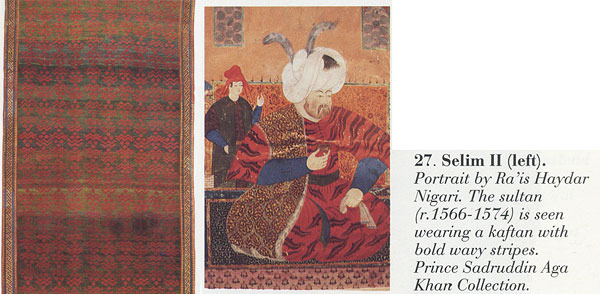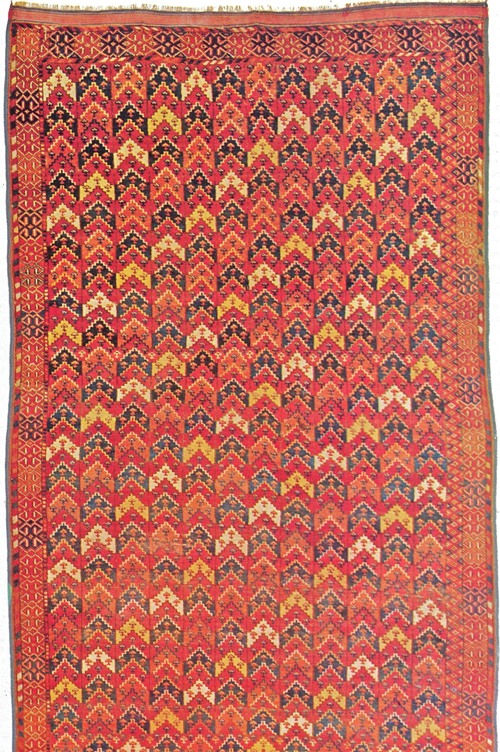|
|||||||
 |
|
|
Thread Tools | Display Modes |
|
|||||||
 |
|
|
Thread Tools | Display Modes |
|
|
#21 |
|
Members
Join Date: Oct 2009
Posts: 153
|
Hi Martin,
I did not know it was as late as that. Anyway, I suppose that the Seldjuk style did not disappear everywhere shortly after the Mongol/Il-khanid raids in Anatolia, as destructive as they might have been. Unless I err, several Beylicks (the little states which dotted Anatolia between the end of the Seldjuk of Rum Empire and the Ottoman leadership) were ruled by Seljuk offspring. Besides, the artisans of Konya for example could have kept the style alive for a while, independently of the ethnic origin of the new political power in place, just as french artisans kept making furniture in Louis XIII style even during the following reigns in which each successive king tried to impose his own style. However the presence of the "waves with hook" on Anatolian Seldjuk monuments and on Il-khanid rugs suggests that this motif was known both in Anatolia and in Persia, perhaps imported by the previous (Oghuz) Turkik waves which swept both regions.  Best regards Pierre |
|
|

|
|
|
#22 |
|
Members
Join Date: Jul 2008
Posts: 121
|
Hi Pierre
Waves and zig-zag are very generic patterns, so unrelated origins is of course a highly likely possibility. But the combination between the zig-zag and the little dot/device at the top of the waves is a bit more specific, so I would agree on an earlier common source. Totally speculative but one could perhaps suggest a relation to the cintamani motif, which as one of multiply interpretations is often seen as a pearl/jewel floating on the top of the ocean (sorry for yet another tunnelvison topic  ) )  best Martin |
|
|

|
|
|
#23 |
|
Members
Join Date: Jul 2008
Posts: 121
|
Hi Pierre
I was wrong about the zig-zag pattern being carved into the pillars - its a painted black contour. Here a few more photos of the pattern which is not only on the pillars, but also as here a panel (almost rug format) and in smaller versions as borders on f.ex pillar heads.  The Esrefoglu Mosque has just in 2011 been put on Unescos world heritage list because of its unique well preserved wooden structures. Supposedly an interior open pit/well has regulated temperature and humidity up till the 1940's. As seen on these photos there has been some restoration/maintenance going on regarding the painted ornaments (there are a lot of interesting painted ornaments, including kufic ornamentation, I will post them in the kufic tread) There seem to be different layers of painted maintenance, some probably not very old, perhaps 20th some much older, but they all seem rather respectful to the original layout, not introducing new styles (except the central Müezzin Mahfili which has a distinctly Ottoman decoration and an inscribed date 1574/75). It doesnt look like that there has been any over-all restoration, its more like continuous patchlike repairs, the latest repair unfinished. This is only my personal judgment, I haven't found any thorough text regarding the painted ornaments.  best Martin |
|
|

|
|
|
#24 |
|
Members
Join Date: Oct 2009
Posts: 153
|
Hi all,
Could this nineteenth century "Beshir" rug be another rare descendent of the Il-khanid (or Seldjuk-) rugs shown in this tread? It sure features a field of "waves with appendices" too. FIG. "Beshir khali. XIX. 332X130. U. Jordan. Oriental Rugs. Vol 5. Turkoman.  The ethnic group: Turkik: (Turkoman, Uzbeck, Kirghiz,..), Persian (Tadjik) or even Arab, which wove each of the various types of so-called "Beshir" rugs is a matter of conjecture, but at least we can assume that their region of origin was the former Khanate of Bukhara. Not that this brings us any further, uuuh?. |
|
|

|
|
|
#25 |
|
Members
Join Date: Jul 2008
Posts: 121
|
Hi Pierre
I am of course very tempted to see a connection the between Beshir rug, the Il-Khanied, the cintamani waves and thus for me the Beshir Yilan motif. But I am also a bit uncertain, there are some missing links and the zig-zag pattern is very generic. But the fact that you have identified a whole group of Il-Khanied rugs with wave pattern and kufic borders is in itself actually totally fascinating  These rugs with their almost clash like meting between border and main field in my opinion have a completely different aesthetic than the Timurid rugs. These rugs with their almost clash like meting between border and main field in my opinion have a completely different aesthetic than the Timurid rugs.best Martin |
|
|

|
 |
|
|